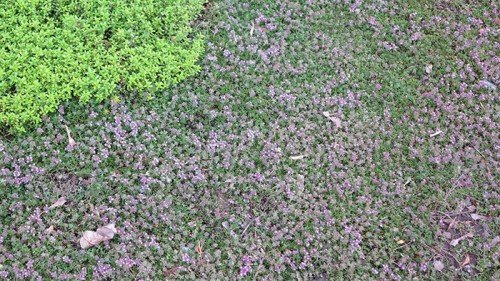
Much has changed in my neighbourhood’s front gardens. When I first came here more than 25 years ago, many had a combination of overgrown junipers and white birch trees. Now, there’s a much broader selection of ornamental conifers and many interesting trees, including tan-pink river birch, purple beech, ornamental cherries, redbuds and dogwoods. But nothing has surprised and delighted me more than the thyme lawn I discovered this weekend.
Thyme has long been a groundcover solution in hot and dry soil locations, but seldom seen as a lawn planting in our cold climate. We use various species of thyme to fill in between plants or to cascade around rocks, but I’ve never seen a true thyme lawn until now. With only a few exceptions, many thyme species are hardy to Zone 6, leaving them perilously close to their frost hardiness limit in my Zone 6a neighbourhood. Thyme plants are often damaged when snow and ice lay over them for several winter months, causing patchy emergence in spring, and requiring replacements to fill the holes. But the thyme lawn I recently saw (in beautiful mauve bloom) has come through just fine, and after a close look, I’ve considered how this was achieved.
My first thought is that we’ve had several consecutively warm winters. I don’t keep track of daily high and low winter temperatures, but I certainly haven’t been wearing my heaviest Nordic sweaters. Even just one degree warmer makes a difference to plant survival in cold climates, and perhaps that has favoured resilience in thyme plants.
My second thought is that correct soil preparation makes a big difference to the vigour of plants with specific soil requirements. Thyme definitely likes sandy and free-draining soil, low nitrogen and maximum sunlight. I’ve been growing thyme in the rich, moist soil of my garden beds, and piling snow from the walkways over it in winter. Was there ever a more disastrous scenario for thyme plants?
The thyme lawn on my road is planted in the front section of lawn abutting the street (the hottest and driest section), and taking up approximately a third of the lawn area. (Space behind the thyme is given over to a huge shrub rose surrounded with yet another lawn of low-growing sedums.) Being basically shameless, I took a moment to explore the soil under the lush carpet of my unknown neighbour’s thyme lawn and found a tough and gritty soil that had been supplied for the location. The combination of warmer winter temperatures and a hot summer location with steep drainage perhaps has resulted in this lovely thyme planting that has made a consistently thick coverage.
The best species for a thyme lawn are the creeping, mat-forming varieties, such as mother-of-thyme (Thymus serpyllum pulegioides, Zone 3) or red creeping thyme (T. serpyllum praecox Coccineus Group, Zone 3). The world of thyme species is large and you might come across other low creeping plants to experiment with. With a hardy variety and a hot, dry, well-drained location, maybe it’s time to establish a thriving lawn or broad strip of beautiful thyme.









Can thyme “lawns” be cut on a regular basis? I understand the timing of a cut may inhibit blooms, but will it kill the thyme?
Hi Louise,
It’s best not to attempt mowing a thyme lawn, because that would damage the plants and disrupt their coverage. When making a thyme lawn, select thyme species with a low, spreading mat form (see some mentioned in the blog), and they will have a reasonably neat, consistent appearance. Being generous in the the number of plants used for the lawn will result in quicker and better coverage of soil. A well-grown thyme lawn will require almost no maintenance. It will bear some foot traffic, but it’s not a surface for play or athletics. Hope that gives you a better sense of what to expect.
– Judith
Thanks so much! I love the idea.
I have been growing large patches of creeping thyme and woolly thyme on the edges of my flower beds in Zone 5a for a number of years. I am dealing with heavy clay, unreliable snow cover, moisture conditions from wet to drought yet the thyme has so far come through each winter in great shape. Some has migrated into the lawn and is so far doing fine
I have creeping thyme growing well (perhaps too well) between large flat rocks in my walkway. The purple flowers are just lovely right now. The plants are rooted in about 1.5 inches of limestone screenings with sandy fill beneath. My home is in Zone 3b but the thyme seems to survive the winters OK, even where I shovel. The thyme that is not exposed to open air in wintertime looks brown and dead first thing in spring but recovers with a bit of watering and sunshine. The exposed thyme has dead-looking holes in spring that rapidly fill in by themselves — no additional planting required. I have never fertilized the thyme in the 5 years since I planted it. I have to trim the edge of the walkway every summer to prevent invasion into my gravel driveway.
Thanks! Now I know where things are going off the rails and “just in thyme” for summer!